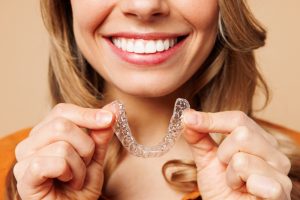Find out everything you need to know about wisdom teeth with our complete guide!
What Are Wisdom Teeth?
Wisdom teeth, or third molars as dentists call them, typically break through your gums between your 17th and 25th birthday. These large teeth help you chew food at the back of your mouth, and they are the last teeth to come in.
However, during regular dental checkups as a teenager, X-rays may reveal that wisdom teeth could come in sideways because there isn’t enough room at the back of your jawbone to help them come in straight. If this is the case, your dentist or orthodontist may recommend surgically removing wisdom teeth before they become an issue. Wisdom teeth that come in sideways can undo years of straightening teeth with braces or Invisalign, so it’s important to take care of wisdom teeth removal sooner rather than later based on your orthodontist’s or dentist’s recommendations.
Why Do We Have Wisdom Teeth?
Back before humans lived in huts and homes, our ancestors needed an extra set of molars to chew hardy plants and raw meat for proper digestion. Our jaws were also larger back then. But, our genetics have not yet compensated for the smaller jaw, which is why many wisdom teeth come in sideways. Dentists call this impacting. Wisdom teeth coming in sideways can cause difficulties for the rest of your mouth and dental health.
Why Might Wisdom Teeth Need to Be Removed?
Wisdom teeth can be helpful when they are healthy and correctly positioned. However, more often than not, they end up creating an array of dental challenges. As a wisdom tooth grows sideways, it presses against the neighboring molar, causing discomfort and pain. Or consider a wisdom tooth that remains trapped within the jawbone or under the gums, which could cause an infection. In other cases, a wisdom tooth may only partially push through the gums, creating a passageway for bacteria to get under the gums to cause an oral infection and gum disease.
Each of these scenarios presents a compelling case for wisdom teeth removal. As with any medical decision, your dentist will consider all relevant factors, including the position and health of your wisdom teeth, your overall oral health, and your personal comfort level, before recommending extraction. Ultimately, we want you to have a happy and healthy smile.
What Are the Signs I Need Wisdom Teeth Removed?
The first sign comes from X-rays of your mouth before your wisdom teeth start impacting or poking through the gums. Our dentists can detect these issues before they become a problem.
Other signs you might need wisdom tooth removal include, but are not limited to:
- Swollen gums
- Consistent jaw pain
- Problems opening and closing your mouth
- Bad taste in your mouth
- Soreness and bleeding of gums
- Gradual crowding of your teeth
- Misalignment of your teeth that wasn’t present before
- Cavities in the wisdom tooth due to incorrect placement
- Decay
- Gum disease
Again, your dentist can help diagnose any problems with wisdom teeth during a comprehensive exam.
Prepare for Wisdom Teeth Removal Ahead of Time
If you need to be sedated, prepare a few things beforehand.
Bring a Friend or Loved One
Not only will you get moral support from a friendly face, but you will also have someone there to take care of you, bring you to the appointment, and transport you back home as you recover from the anesthesia.
Stock Up on Foods That Require Little to No Chewing
If you love ice cream, yogurt, or soup, then this will be easy for you. Make sure anything you consume will not aggravate your stitches. Also, make sure your meals are easy to prepare. You’ll likely be feeling the effects of a painkiller, so keep meals simple over the next couple of days.
Dress Comfortably
When you head to the office, we recommend a T-shirt and sweatpants for wisdom teeth removal. You’ll be more comfortable with loose-fitting casual clothes.
Keep School or Work Informed of a Timeline for Recovery
Your recovery time is very important after wisdom teeth removal. Returning to work or school before you are ready can hinder the healing process. People will understand your situation if you communicate with them ahead of time. Expect to take things slow for a week to facilitate the recovery process. That doesn’t mean ceasing all activities. It just means giving your mouth time to heal.
What Happens During Wisdom Teeth Removal?
Before any surgery, your dentist or oral surgeon will assess your mouth and jaw to determine what procedure is appropriate for wisdom tooth removal. The doctor will screen for any potential health issues that could impact the procedure. You should also plan to take the entire day off work or school.
Wisdom tooth removal represents a routine procedure often performed by an oral surgeon or a general dentist trained in oral surgery. You can get this done at the dentist’s office.
Depending on where the wisdom teeth are, it may just take a local anesthetic to numb the area where your wisdom teeth are located. For wisdom teeth that haven’t broken through the gums yet, your dentist or oral surgeon may administer a general anesthetic during the entire procedure.
Don’t worry. You’ll fall asleep and then wake up a few hours later with the wisdom teeth completely extracted. You’ll be back up and going on with your day soon afterward.
Once you’re comfortably numb or sedated, your dentist will make a small incision to expose the wisdom tooth and then carefully remove it using specialized tools for just such an occasion. You’re in excellent hands with our staff at Parkcrest Dental Group!
After the tooth is successfully removed, the dentist will clean the extraction site. Then, they will suture the wound with dissolvable stitches, if necessary, so there is no need to worry about returning for their removal.
If you have a more straightforward extraction and not oral surgery, you might need to place a gauze pad over the extraction site. This helps control any bleeding and aids in the formation of a blood clot. The gauze pad acts like a band-aid, protecting the wound as it begins to heal.
Recovery and Post-Operative Care After Wisdom Teeth Removal
You can expect the recovery period after wisdom teeth removal to span over a few days. Definitely have someone drive you to the appointment and drive you home.
Use Ice for the Swelling
The first thing you’ll notice is swelling, followed closely by mild discomfort. Your doctor will instruct you to apply an ice pack to the affected area to help reduce the swelling while also numbing the area to relieve discomfort. Try to keep ice on there for 20 minutes at a time, and then take a break for an hour or two.
Stop Bleeding With Gauze
If you have an extraction, your dentist might instruct you to keep gauze on the extraction site for a few hours to stop the bleeding. You must change the gauze every 15 minutes until there is no more bleeding.
For patients with oral surgery, the dissolvable stitches will effectively stop any bleeding.
Manage Any Pain With Medications
You’ll likely feel pain for a few days immediately following the procedure. Your dentist will likely prescribe pain medication to take as directed. Once the pain becomes more manageable, your doctor may instruct you to switch to over-the-counter pain relievers such as ibuprofen or acetaminophen. Your doctor may also prescribe an antibiotic to prevent an infection.
Eat Soft Foods for a Few Days
Rely on a soft diet of easy-to-prepare foods. Soup, yogurt, mashed potatoes, and smoothies should be your go-to choices. Also, remember to stay hydrated, but avoid using a straw as the suction action might dislodge the blood clot at the extraction site.
Gently Clean Your Mouth and Teeth
It’s crucial to maintain oral hygiene after wisdom teeth removal, but gently so. Brush your teeth, but avoid the surgery area for a day or two. After 24 hours, rinsing your mouth gently with warm salt water can also be beneficial. Try not to swish the salt water around too much.
When to Call or See Your Dentist After Wisdom Teeth Removal
If you experience any of these symptoms following your wisdom teeth removal, call our office. These may be signs of an infection.
- Difficulty swallowing or breathing
- Excessive bleeding
- Fever
- Severe pain not relieved by prescribed pain medications
- Swelling that worsens after two or three days
- A bad taste in your mouth not removed with saltwater rinsing
- Pus in or oozing from the socket
- Persistent numbness or loss of feeling
- Blood or pus in nasal discharge
You may not need to see your dentist right away for a follow-up appointment if you don’t have complications or don’t need stitches removed. If you have any questions about your recovery period, of course, contact your dentist or oral surgeon.
What About Dry Socket Following Wisdom Teeth Removal?
A dry socket can occur if a blood clot doesn’t form properly after a tooth is extracted. To help aid in healing, please take these precautions to keep the extraction or surgery site intact and prevent dry socket:
Avoid Smoking or Vaping
Patients who smoke are at a much higher risk of developing dry socket after a tooth extraction. Inhaling smoke can dislodge your blood clot. This includes cigarettes, e-cigarettes, or any other substance.
Don’t Use Straws
Much like smoking, the suction that occurs when drinking through a straw can have the same effect of dislodging the blood clot. Avoid using straws for at least a week after wisdom teeth removal.
Eat Soft Foods
Eating foods that require chewing or biting can also damage the blood clot in the extraction spot. Stick with foods like applesauce, yogurt, soup, and mashed potatoes.
Maintain Proper Oral Hygiene
Keeping your mouth clean is essential to avoid dry socket. Ask your dentist how to properly and safely brush your teeth following wisdom teeth removal. It may be best to gently rinse your mouth instead of brushing for the first few days, depending on your dentist’s instructions.
Wisdom Teeth Removal at Parkcrest Dental Group in Springfield, Missouri
We provide general dentistry services, as well as pediatric dentistry and orthodontics in Springfield, MO. Visit us online to book an appointment or call us at 417-887-1220.




